Still More True Tales of Tribeca Buildings
The History of Tribeca Buildings database—compiled from Tom Miller’s posts at Daytonian in Manhattan—has six more entries on the properties below. (Click the address to read the full text.) If you enjoy these, and you will, then you should definitely check out his website, which also has write-ups about buildings all over the island. And don’t miss his book, Seeking New York: The Stories Behind the Historic Architecture of Manhattan—One Building at a Time.
··················
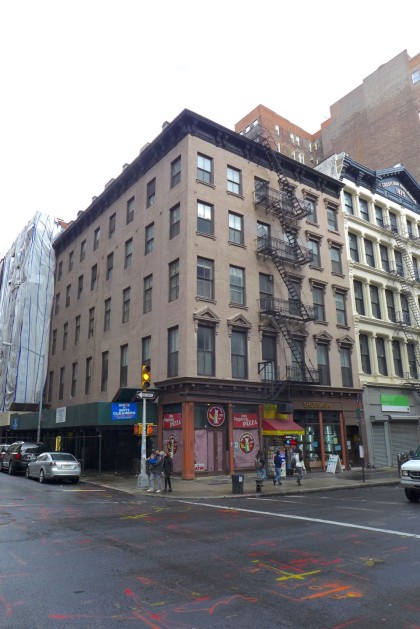 381-383 BROADWAY
381-383 BROADWAY
On November 11, 1882, The Record and Guide reported that Richard S. Clark “proposes to tear down the old brick building, No. 383 Broadway, and erect an office building to be joined to his other building [381 Broadway] on the northwest corner of Broadway and White street.” Clark would not live to see his proposal carried out. It was more than three years later when, on February 13, 1886, The Record and Guide reported, “A fine store will be erected at No. 383 Broadway, which is now being torn down.” The Richard Smith Clark estate had commissioned the architectural firm of J. & D. Jardine to design the building. The owners gave the brothers, David and John, surprising instructions—the new structure should match exactly the design of the nearly 40-year old building on the corner. The result was seamless, visually doubling the size of the original structure.
··················
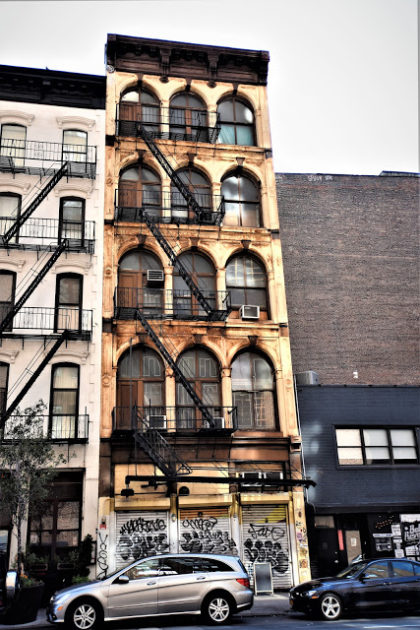 309 CHURCH / 34 WALKER
309 CHURCH / 34 WALKER
By the late 19th century, P. O’Doughtery & Sons had been in the building for years. Importers of “linens, woollens, and shawls,” the firm was established by Patrick O’Doughtery and now included his sons Francis and Daniel as partners. In order to facilitate their acquisition of Irish linens, the O’Doughterys employed a representative in Ireland, Charles Malley, who routinely traveled back and forth between Donegal and New York. Malley was a steerage passenger on the City of Rome when it docked in New York on June 21, 1891. He was shocked when General O’Beirne, the Assistant Superintendent of Immigrants, refused to allow him to leave the ship. O’Beirne declared that Malley “had no money and was liable to become a public charge.” A representative from P. O’Doughtery & Sons rushed to the dock, accompanied by two bondsmen for Malley. Despite the endorsement and the officer to post bond, O’Beirne was adamant. The New York Times reported that he “flatly refused to accept a bond in the case, and is reported as saying that no power this side of heaven could retain the man in this country.” O’Beirne defended his decision to the newspaper’s reporter, saying that the Irishman was most likely to become a financial burden to the city. When the reporter pointed out that P. O’Doughtery & Sons had offered a bond to ensure that did not happen, the immigration officer stood pat. The Times reported that he said that the law “made it discretionary with him whom to reject, and that he proposed to exercise the power in this case.” Malley was sent back to Ireland.
··················
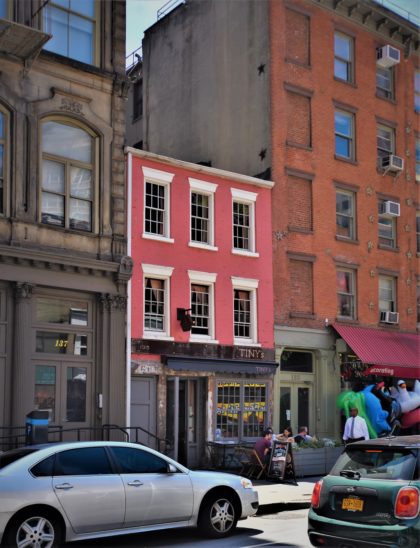 135 W. BROADWAY
135 W. BROADWAY
In 1861, George Mudeking and his wife, Margaret, purchased No. 37 [as 135 W. Broadway was then numbered], and moved into the upper floors. Mudeking described himself as a “cigar merchant” and the store as a “grocery.” Both terms were diplomatically flattering. In fact, Mudeking operated his saloon here. Six years later, on April 23, 1867, he opened for business as usual. The problem was it was an election day. He was arrested for violating the law prohibiting anyone to “publicly keep, sell, give away or dispose of any strong or spirituous liquors, wines, ale or beer” within a quarter mile of a polling place.
··················
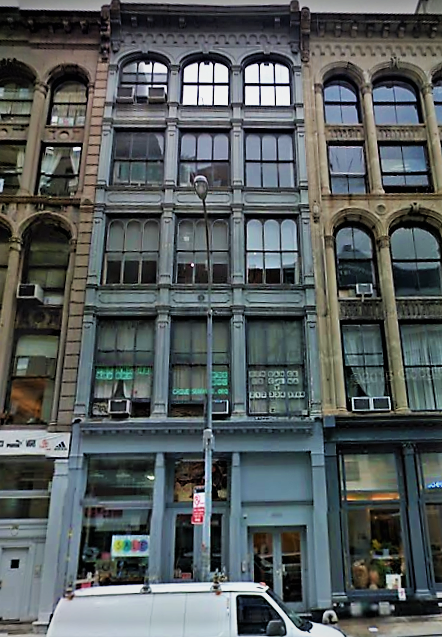 390 BROADWAY
390 BROADWAY
The dry goods store of Cornell & Amerman was on the ground floor of the building in 1882 when enterprising thieves devised a clever plan. The firm stored stock in the basement, the windows of which faced Cortlandt Alley to the rear. Those windows were protected by heavy iron bars. But the bars were spaced widely enough to allow bolts of fabric to pass through. Somehow one crook managed to hide in the basement on September 4. Under cover of night, his confederates broke two of the window panes and, using a “stout wire” hoisted bundles of cambric fabric out. But in the middle of the heist a policeman entered the alley on his nightly rounds. When he reached the rear of No. 390, he found one bolt of fabric on the pavement. The Times reported, “The thieves must have been surprised at their work by the approach of the policeman, and in their flight dropped one of the pieces in the street.” The inside man apparently escaped out the Broadway entrance.
··················
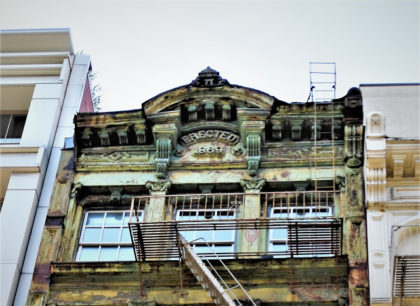 49 WALKER
49 WALKER
In 1888, Meyer Gans, cloak manufacturer, was here, as was the Morris Brothers suspender factory. On April 26 of that year, a fire broke out in the building. It was quickly extinguished and there was little damage either by fire or water. But Morris Brothers quickly realized they had suffered a different type of loss. Unscrupulous firefighters sometimes took advantage of the chaos of blazes to help themselves to goods. In the worst cases some rogues were convicted for setting the fires in order to gain access to the booty. On April 28, 1888, The Evening World reported, “No new light has been thrown upon the alleged theft of suspenders in the store of Morris Brothers…during the fire.” There was no question as to who the perpetrators were in the mind of Abram Morris. The World said, “He has no doubt that the robbery was committed by a member of the Fire Department, for there were no outsiders in the building.” According to the article the brothers explained, “Their money loss is comparatively trifling, but they are indignant that it should become necessary to keep a watch on those who are paid to protect their property.”
··················
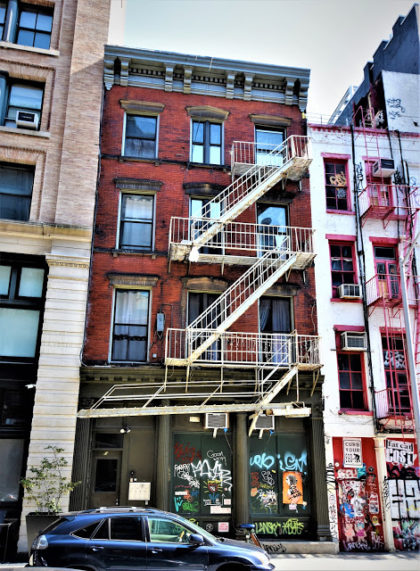 53 LISPENARD
53 LISPENARD
Michaelis Borchardt’s neckwear factory was on the third floor in the mid-1880s. Rather surprisingly, he brought his expensive wedding presents to the office for safekeeping in 1887 and placed them in the large safe. On September 10, police were called when the safe was found broken into and its contents emptied. The Sun reported that the store “was entered by burglars some time on Friday night and his safe, full of silk, was blown open and robbed of its contents. It is supposed that one of the burglars secreted himself in the hall before the building was closed for the night, and let in his pals when the coast was clear.” Borchardt valued the loss of imported silk at $7,000—a significant $182,000 in today’s dollars. “His wedding presents, which were in the safe, were also taken,” noted the article. But the police were more baffled as to how the supposed crooks got away unnoticed. The Sun said, “How the burglars got away with their booty when, as the posts are short in that part of the town, policemen pass or ought to pass, the robbed building on Canal and Lispenard streets every few minutes is a mystery.” Michaelis Borchardt owed $2,500 to six creditors at the time. Given his substantial loss in the robbery, he offered to pay each of them 25 cents on the dollar, “payable in March 1888” as reported in The Clothier and Furnisher. His creditors, essentially with no other option, agreed.
··················















